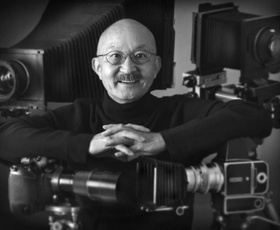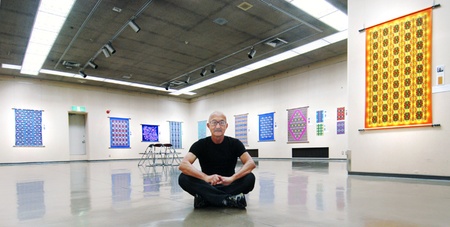Richard Yutaka Fukuhara’s computer-manipulated photographs are classified in the “visionary” category. When asked about this label he responds, “To me visionary means to look beyond what is obvious.” Fukuhara says he fights the battle of the commonly held misconception that he is gifted with ‘a good eye.’ He states adamantly, “It’s not only the eye that determines how one approaches an artistic exploration. What lens, what angle, what lights, who is the audience are among the many considerations determined by mindful, creative, ‘artful’ process.”
Richard Yutaka Fukuhara refuses to tag himself as an arts activist; he sees himself to be a volunteer community activist. Through his artwork he challenges the participants to see beyond what is. He begins with an image, such as a civic landmark, from our collective daily lives and mindfully, with great care, deconstructs it in microcosmic, systematic degrees. He then uses these computer-manipulated photographic images to re-create bold, holistic pattern formations based on his unique perspective and interest in the specific part and its relationship to the whole. His palette: historical structures, modern skyscrapers, alleyways, fire escapes, street lamps and archways, stimulates the senses of the viewer with stunning mosaics re-envisioned from the architectural structures of our every day experience.
So what’s the point of his kaleidoscopic work?
“Have you ever taken the time to watch the sun fall into the ocean? Have you ever watched a ‘mommy bird’ attack a bigger bird while the ‘mommy bird’ was protecting her nest? Have you ever picked up a stone and examined the colors and wondered how old it was—probably eons older than you? Have you ever seen a whale “spy hop” out of the water? Have you ever looked deeply into the eyes of a child when he or she smiles? Have you ever held the hand of a person before he or she takes their last breath before falling into eternal sleep?” Fukuhara explains, “These revelations are all elements of the spirit of the life force. My artwork is what it is; it’s a part of life. My work attempts to provoke feelings of wonderment and exploration. Some understand Picasso; others do not. In Picasso’s later works he was able to use a minimum of line to stimulate a response from the viewer. Some understood; some did not.” According to Fukuhara we all view life, nature and art from our own prejudices, perspectives or experiences, none of which can of itself be the whole truth of the object. Only by collectively viewing many perspectives can the mindful person approach a true understanding of the whole.
Fukuhara’s artwork is rooted deep in the prejudices and experiences of America’s Japanese internment camps. “I was born in 1944 at “Camp” Minidoka, Idaho. We returned to Los Angeles after we were released from “Camp” in August of 1945. When we arrived, Dad was carrying my 2 ½ year old sister, Sandy. Mom carried me, and my 5 year old brother, Victor, tagged along as we exited Los Angeles Union Station. Similar to many families in our situation, we had no living arrangements. An old pick up truck pulled up in front of us. Two Japanese Americans asked if we had a place to stay. They helped my family into the bed of the truck. They took us to Union Church in Los Angeles’s Little Tokyo community. Union Church and other churches and Buddhist temples were converted into sleeping quarters for the ‘homeless’ families released from the interment camps.”
Today that homeless shelter is a theater, video company and art gallery. At this very site, 50 years after his family was sheltered, Richard recently exhibited his “Tapestries of Los Angeles” art exhibit. These same walls that provided a safe haven for his family have now promoted his vision for The Dream—One People/One Nation/One World, all in one glorious series of harmonic patterns generated from his family’s experiences rebuilding and sustaining their economic self-sufficiency and social order.
Fukuhara’s “Tapestries” series is a combination of what he began creating long before computers were available. “I was interested in shapes and forms, creating shapes from forms and forms from shapes, since eighth grade. I was constantly drawing shapes and forms while “copiously” taking notes in history class.”
Through his older brother’s encouragement, Victor was already trained in photography, Richard began with a Kodak Brownie. Now with computers, a Nikon D2x and D200 with 2.8 17 to 55 mm lens, an 18 to 135 zoom lens, a 12 to 24 mm wide angle lens and a Sinar Digital Back, he is able to create his vision, reflecting all his experience and utilizing state-of-the-art communication technology.
Richard’s goal is to facilitate others to look, see and think beyond the printed paper. “The TAPESTRIES series is part of my legacy. My vision for the future is to see people smiling and hear the laughter and amazement of children when confronted with Life’s magic. I love to hear people say, “I love you.” I want to share my appreciation for the lessons of life taught me by my parents, who are my heroes.” It is this open-minded, holistic generosity of spirit that makes Richard Yutaka Fukuhara an internationally recognized fine artist.
*Contact yolanthapace@gmail.com for rewrite permission.
© Copyright 2010 Yolantha Harrison-Pace * All Rights Reserved






